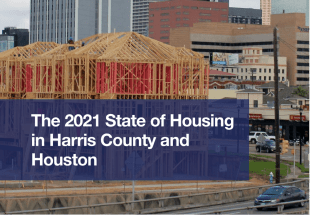HOUSTON – (June 22, 2021) – Houston's share of homeowners is dropping, and a growing number of renters interested in buying a home find themselves shut out of the market, according to a new report from Rice University's Kinder Institute for Urban Research. At the same time, a rising number of tenants are having a hard time paying their rent, contributing to a staggering eviction rate in Harris County.

“The 2021 State of Housing in Harris County and Houston” examines data from 2018 to 2019 and compares how dozens of key housing indicators shifted. The Kinder Institute's first housing report, using data from 2010 to 2018, was released last year, and subsequent annual reports will add the latest year of available data to the analysis while tracking trends. Researchers Stephen Averill Sherman, John Park, Luis Guajardo, Kyle Shelton, Jenna Lessans, Ksenia Mokrushina and William Fulton contributed to the report.
The researchers said tenants’ struggling to pay rent or buy homes are bound to find it even more difficult because of rising construction costs.
"Median sales prices in the county are around $230,000, meaning that a 20% down payment of $46,000 exceeds the 2019 renter household median income ($42,257 in the county, $41,231 in the city)," the report read. Meanwhile, the stock of affordable rental units in the county — those with a gross rent of less than $1,000 per month — decreased while the number of units with rents higher than $1,500 increased, continuing a trend seen in the previous report.
Economic and racial segregation and inequality have exacerbated housing woes.
Black and Hispanic home loan applicants are denied mortgages at higher rates than others, and when their loans are approved they generally pay higher interest rates on lower-value homes, the researchers found. In addition, the areas where poor and working-class residents can afford to buy or rent are shifting farther outside the city center, which means they are also farther from services, jobs and other opportunities essential for upward mobility.
As a result, concentrated poverty in the suburbs is on the rise. This exodus from the city to the far reaches of Harris County and neighboring counties has also caused Houston and Harris County to become older and less diverse as the neighboring suburban areas outpace their growth.
The report also found that most middle-income renters pay more than 30% of their income for housing and they may have trouble affording necessities such as food, clothing, transportation or health care. And homeowners looking to buy a new home have found that average home prices are rising faster than their incomes. This disparity is forcing many home buyers to move outside the county.
Flooding also remains a significant risk for Houston area residents as homes continue to be built in the existing 100- and 500-year flood plains. In fact, construction in these areas grew between 2018 and 2019.
"The city and county have around $15 billion and $30 billion of residential home value built in these flood plains," the report read. "Units in the flood plain outnumber insurance policies countywide by a ratio of 4 to 1, meaning that a massive amount of residential wealth is vulnerable to washing away in the next storm." The risk is compounded by the fact that lower-income households have fewer resources to weather a disaster.
The report also found that renters in Houston and Harris County are three times more likely to live in overcrowded homes than homeowners. Before the economic challenges brought on by the COVID-19 pandemic, overcrowded rental properties — those with more than 1.5 residents per room — increased 25% between 2018 and 2019, which researchers said likely contributed to the spread of the virus when it arrived in 2020.
The researchers hope the report will help policymakers, housing providers and residents recognize and respond to the challenges posed by the big picture of housing in the Houston area.
The report is available online at https://kinder.rice.edu
-30-
This news release can be found online at news.rice.edu.
Follow Rice News and Media Relations on Twitter @RiceUNews.
Related materials:
Photo link: https://news-network.rice.edu/news/files/2021/06/housing.png
Photo credit: Kinder Institute for Urban Research.
Located on a 300-acre forested campus in Houston, Rice University is consistently ranked among the nation’s top 20 universities by U.S. News & World Report. Rice has highly respected schools of Architecture, Business, Continuing Studies, Engineering, Humanities, Music, Natural Sciences and Social Sciences and is home to the Baker Institute for Public Policy. With 3,978 undergraduates and 3,192 graduate students, Rice’s undergraduate student-to-faculty ratio is just under 6-to-1. Its residential college system builds close-knit communities and lifelong friendships, just one reason why Rice is ranked No. 1 for lots of race/class interaction and No. 1 for quality of life by the Princeton Review. Rice is also rated as a best value among private universities by Kiplinger’s Personal Finance.
If you would rather not receive future communications from RiceUniversity2, let us know by clicking here.
RiceUniversity2, Public Affairs - MS610 6100 Main Street, Houston, TX 77005-1827 United States

